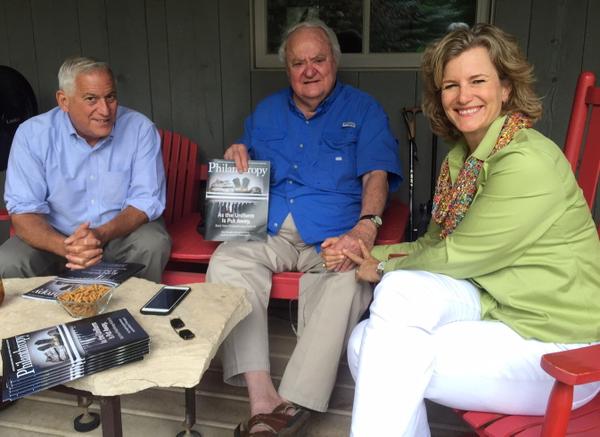 From Big Success to Local Succor
From Big Success to Local Succor
As leaders of educational organizations, we’re often asked about impact. How do we know we’re making a difference? Whether we’re teaching first-generation college-goers or inspiring thought leaders and business people, the question is the same: How do we know that the information seeded in minds works its way through people’s hearts and changes lives for the better.
Around age 40, he shifted into a new gear—one in which his success was measured by how well he could share his wealth. He was influenced in part by several lengthy conversations with a new minister. “I came to realize that expanding my philanthropic activities could be both meaningful and fun,” Calaway recalls. The more he gave, the happier he was. “I sold my house and downsized, ditched the boat, drove a Prius, and began living a more simple life. It was refreshing.”
Giving became a source of happiness, purpose, and community connection. “You don’t see too many U-Hauls behind hearses,” he quips, “so why not give it all away while you can enjoy doing so?” At age 84 he now lives in the small, earthy mountain town of Carbondale, Colorado. His neighborhood elementary school is mostly full of children whose parents work in the tourism or service industry upriver in Aspen—where houses regularly sell for $20 million. (Even amid the national housing downturn, at one point in 2011 the lowest-priced single family home in Aspen was listed for $559,000; it was in a trailer park.)
Calaway grew up a child of the Great Depression, and knowing the dichotomy between wealth and poverty made him want to help bridge the gap. He gets to know his community by having lunch at the Valley View Hospital cafeteria, the Colorado Mountain College Spring Valley campus dining hall, and a local pub called the Pour House that now has a special corner table designated as “Jim’s office,” where he talks with students and doctors and waitresses.
Enthralled by ideas
It was the Aspen Institute that brought Calaway to the Colorado mountains in the early 1970s. He started attending its seminars and purchased a condo in the area to be closer to events and conversation. He met Connie Hill, a student of the Aspen Music Festival and School, and married her. It was only a matter of time before the Calaways moved to the Roaring Fork Valley for good.
Jim’s philanthropy shifted when his residence did, moving mostly to locally rooted causes—“smaller organizations with heart.” He helped renovate an old elementary school into a catalyst for community development. He was one of the founders of the Thunder River Theatre Company, a local cultural hub. He raised money for a new Colorado Animal Rescue Shelter that has since cared for and placed 12,000 animals.
He also joined the board of the group that drew him to his new home: the Aspen Institute. With his own education having been career-focused, he dove into Aspen’s cultural programming. He even began taking liberal arts courses “for the pure joy of learning.” His initial class at Colorado Mountain College, a two- and four-year degree-granting institution with 11 campuses spread across the Rocky Mountains, turned into a passion for institutions that make quality education available to everyone.
“While living in Aspen, I often chatted with kids working in the restaurants, stores, and hotels,” says Calaway. “I learned many of them felt education was out of reach financially. Around that time, I became aware of the vital role of community colleges, and specifically CMC. It’s a unique jewel offering a wide range of certificates, associate and bachelor’s degrees, and life-long learning for transplants like me. I began giving scholarships for local kids to attend. I would meet with the students I supported each semester and was so impressed with what they were learning and how their lives were changing through education. I felt a great sense of pride in providing the resources for kids to get their degree. So scholarships became a pillar of my charitable giving.”
Calaway helped put together an alliance between Colorado Mountain College and the Aspen Institute. The new media school, partially hubbed at the college’s Aspen campus, for instance, is able to have its students interview national and world leaders who come to the annual Aspen Ideas Festival, the X Games, and other popular events. He has also asked philanthropist friends to support both organizations. One couple pledged a million-dollar gift for student scholarships and program development at the school last year.
Calaway encourages donors to avoid anonymous giving. “When someone’s name is on a building or a program, it influences others to join in,” he explains. Valley View Hospital’s Calaway-Young Cancer Center is but one example of his tenacity in recruiting matching donors who agree to lend their names to projects if he commits to doing the same.
“One year, we were expanding and renovating the athletic facility at our Aspen campus that Jim had initially funded,” remembers Aspen Institute executive vice president Amy Berg. “Another set of donors wanted their names on the new building. We asked Jim if he would relinquish his naming rights. He immediately agreed. What could have been an awkward conversation turned into another example where Jim recognized the larger cause.”
“Over my 84 years, I have developed my own philosophy,” says Calaway. “Help others. Cherish all living creatures. Be kind. For me, that is the essence of life.”
Carrie Besnette Hauser is president of Colorado Mountain College. Walter Isaacson is president of the Aspen Institute and namesake of the Isaacson School for New Media at Colorado Mountain College.
